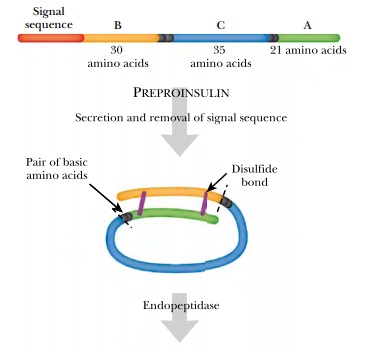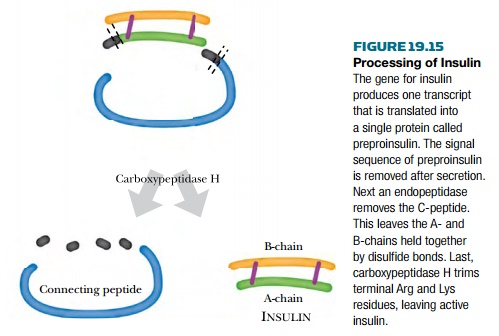Chapter: Biotechnology Applying the Genetic Revolution: Noninfectious Diseases
Insulin and Diabetes
INSULIN
AND DIABETES
Diabetes mellitus is actually a group of
related diseases in which the level of glucose in the blood and/or urine is
abnormally high. There is considerable variation in the detailed symptoms, and
multiple genes are involved. Many cases of diabetes are due to the absence of
insulin , a small protein hormone made by the pancreas, which controls the level
of sugar in the blood. Lack of insulin results in high blood sugar, and this
causes a variety of complications. In patients with insulin-dependent diabetes
mellitus (IDDM), injections of insulin keep blood sugar levels down to near
normal. Other defects affectthe insulin receptor , and so these will notrespond
to insulin treatment.


Insulin is a protein made of two
separate polypeptide chains, the A- and B-chains ( Fig. 19.15 ). Disulfide bonds
hold the two chains together. Although the final protein has two polypeptide
chains, insulin is actually encoded by a single gene. The original gene product,
preproinsulin , is a single polypeptide chain, which contains both the A- and
B-chains together with the C- (or connecting) peptide and a signal sequence.
Preproinsulin itself is not a hormone but must first be processed to give insulin.
The signal sequence at the N-terminal end is required for secretion and is then
removed by signal peptidase. This leaves proinsulin . Removal of the C-peptide requires
endopeptidases that cut within thepolypeptide chain. These recognize pairs of
basic amino acids at the junctions of the Cpeptide with the A- and B-chains.
Finally, the terminal Arg and Lys residues are trimmed off by carboxypeptidaseH
Related Topics